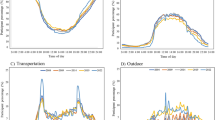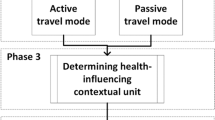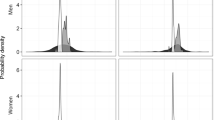Abstract
Personal exposure to environmental substances is largely determined by time–microenvironment–activity patterns while moving across locations or microenvironments. Therefore, time–microenvironment–activity data are particularly useful in modeling exposure. We investigated determinants of workday time–microenvironment–activity patterns of the adult urban population in seven European cities. The EXPOLIS study assessed workday time–microenvironment–activity patterns among a total of 1427 subjects (age 19–60 years) in Helsinki (Finland), Athens (Greece), Basel (Switzerland), Grenoble (France), Milan (Italy), Prague (Czech Republic), and Oxford (UK). Subjects completed time–microenvironment–activity diaries during two working days. We present time spent indoors — at home, at work, and elsewhere, and time exposed to tobacco smoke indoors for all cities. The contribution of sociodemographic factors has been assessed using regression models. More than 90% of the variance in indoor time–microenvironment–activity patterns originated from differences between and within subjects rather than between cities. The most common factors that were associated with indoor time–microenvironment–activity patterns, with similar contributions in all cities, were the specific work status, employment status, whether the participants were living alone, and whether the participants had children at home. Gender and season were associated with indoor time–microenvironment–activity patterns as well but the effects were rather heterogeneous across the seven cities. Exposure to second-hand tobacco smoke differed substantially across these cities. The heterogeneity of these factors across cities may reflect city-specific characteristics but selection biases in the sampled local populations may also explain part of the findings. Determinants of time–microenvironment–activity patterns need to be taken into account in exposure assessment, epidemiological analyses, exposure simulations, as well as in the development of preventive strategies that focus on time–microenvironment–activity patterns that ultimately determine exposures.
This is a preview of subscription content, access via your institution
Access options
Subscribe to this journal
Receive 6 print issues and online access
$259.00 per year
only $43.17 per issue
Buy this article
- Purchase on Springer Link
- Instant access to full article PDF
Prices may be subject to local taxes which are calculated during checkout
Similar content being viewed by others
References
Ackermann-Liebrich U, Viegi G., and Nolan C., Eds. Time–Activity Patterns in Exposure Assesment. European Commission, Directorate-General XII, Brussels, Luxemburg, 1995. Air Pollution Epidemiology Report Series; No. Report Number 6.
Adair J.H., and Spengler J.D. Time activity and exposure assessment: the six city indoor air quality experience. Paper presented at: 82nd Annual Meeting and Exposition of the Air and Waste Management Association (Paper No. 89-100.5), Anaheim, CA 1989.
Altergott K., and McCreedy C. Gender and family status across the life course: constraints on five types of leisure. Soc Leisure 1993: 16: 151–180.
Baranowski T., and de Moor C. How many days was that? Intraindividual variability and physical activity assessment. Res Q Exer Sport 2000: 71 (2 Suppl): 574–578.
Boudet C., Zmirou D., Künzli N., and Oglesby L. Subjects adapt time–activity patterns during participation in a personal exposure assessment study. Paper presented at: 7th Annual Meeting of the International Society of Exposure Analysis, Nov. 2–5, Research Triangle Park, NC 1997.
Chapin F.S. Human Activity Patterns in the City: Things People do in Time and Space. John Wiley & Sons, New York, 1974.
Dorre W.H. Time–activity-patterns of some selected small groups as a basis for exposure estimation: a methodological study. J Exp Anal Environ Epidemiol 1997: 7: 471–491.
Echols S.L., MacIntosh D.L., Hammerstrom K.A., and Ryan P.B. Temporal variability of microenvironmental time budgets in Maryland. J Exp Anal Environ Epidemiol 1999: 9: 502–512.
Echols S.L., MacIntosh D.L., and Ryan P.B. Temporal patterns of activities potentially related to pesticide exposure. J Exp Anal Environ Epidemiol 2001: 11: 389–397.
Eurostat. Comparable time use statistics — National tables from 10 European countries. Office for Official Publications of the European Communities, Luxembourg, 2005.
Eurostat. How Europeans spend their time — Everyday life of women and men.. Office for Official Publications of the European Communities, Luxembourg, 2004.
Eurostat. Time use at different stages of life — Results from 13 European countries.. Office for Official Publications of the European Communities, Luxembourg, 2003. 92-894-6047-4.
ExpoFacts. European exposure factor database for exposure assessment and risk analysis. http://www.ktl.fi/expofacts, 2005.
Freeman N.C., Lioy P.J., Pellizzari E., Zelon H., Thomas K., Clayton A., and Quackenboss J. Responses to the region 5 NHEXAS time/activity diary. national human exposure assessment survey. J Exp Anal Environ Epidemiol 1999: 9: 414–426.
Freeman N.C., Waldman J.M., and Lioy P.J. Design and evaluation of a location and activity log used for assessing personal exposure to air pollutants. J Exp Anal Environ Epidemiol 1991: 1: 327–338.
Graham S., and McCurdy T. Developing meaningful cohorts for human exposure models. J Exp Anal Environ Epidemiol 2004: 14: 23–43.
Gruffermann S. Complexity and the Hawthorne effect in community trials [editorial; comment]. Epidemiology 1999: 10: 209–210.
Hänninen O., Alm S., and Katsouyanni K., et al. The EXPOLIS study: implications for exposure research and environmental policy in Europe. J Exp Anal Environ Epidemiol 2004: 14 (6): 440–456.
Jantunen M.J., Hanninen O., and Katsouyanni K., et al. Air pollution exposure in European cities: the “EXPOLIS” study. J Exp Anal Environ Epidemiol 1998: 8: 495–518.
Jenkins P., Phillips T., Mulbert E., and Hui S. Activity patterns of Californians: use of and proximity to indoor pollutant sources. Atmos Environ 1992: 26A: 2141–2148.
Johnson T., Capel J., and McCoy M. An Analysis of Ten Time/Activity Databases: The Effect of Selected Factors on the Apportionment of Time Among Microenvironments and Breathing Rate Categories. IT Corporation, Durham, NC, 1995.
Klepeis N.E., Nelson W.C., and Ott W.R., et al. The National Human Activity Pattern Survey (NHAPS): a resource for assessing exposure to environmental pollutants. J Exp Anal Environ Epidemiol 2001: 11: 231–252.
Koistinnen K., Kousa A., and Tenhola V., et al. Fine particle (PM2.5) measurement methodology, quality assurance procedures and pilot results of the EXPOLIS Study. J Air Waste Manage Assoc 1999: 49 (10): 1212–1220.
Leech J.A., Nelson W.C., Burnett R.T., Aaron S., and Raizenne M.E. It's about time: a comparison of Canadian and American time–activity patterns. J Exp Anal Environ Epidemiol 2002: 12: 427–432.
McCurdy T., and Graham S. Using human activity data in expsoure models: analysis of discriminating factors. J Exp Anal Environ Epidemiol 2003: 13: 294–317.
McGraw K., and Wong S. Forming inferences about some intraclass correlation coefficients. Psychol Methods 1996: 1 (1): 30–46.
Nelson W., Ott W., and Robinson J. The National Human Activity Pattern Survey (NHAPS): Use of Nationwide Activity Data for Human Exposure Assessment: Presented at 87th Annual Meeting and Exhibition of the Air & Waste Management Association, (Paper no. 94-WA75A.01) 1994.
Oglesby L., Rotko T., and Krütli P., et al. personal exposure assessment studies may suffer from exposure relevant selection bias. J Expo Anal Environ Epidemiol 2000: 10: 251–266.
Ott W.R. Human activity patterns: a review of the literature for estimating time spent indoors, outdoors, and in transit. Paper presented at: Proceedings of the Research Planning Conference on Human Activity Patterns, Las Vegas, NV 1989.
Quackenboss J.J., Spengler J.D., Kanarek M.S., Letz R., and Duffy C.P. Personal exposure to nitrogen dioxide: relationship to indoor/outdoor air quality and activity patterns. Environ Sci Technol 1986: 20: 775–783.
Robertson G.L., Lebowitz M.D., O'Rourke M.K., Gordon S., and Moschandreas D.J. The National Human Exposure Assessment Survey (NHEXAS) study in Arizona — introduction and preliminary results. J Exp Anal Environ Epidemiol 1999: 9: 427–434.
Robinson J.P. Time-diary research and human exposure assessment: some methodological considerations. Atmos Environ 1988: 22: 2085–2092.
Robinson J.P., and Blaire J. Estimating exposure to pollutants through human activity pattern data: the national microenvironmental activity pattern survey. Annual Report, Survey Research Center, University of Maryland; 1995.
Rotko T., Kousa A., Alm S., and Jantunen M. Exposures to nitrogen dioxide in EXPOLIS-Helsinki: microenvironment, behavioral and sociodemographic factors. J Exp Anal Environ Epidemiol 2001: 11: 216–223.
Rotko T., Oglesby L., Kunzli N., and Jantunen M.J. Population sampling in European air pollution exposure study, EXPOLIS: comparisons between the cities and representativeness of the samples. J Exp Anal Environ Epidemiol 2000: 10: 355–364.
Schwab M., Colome S.D., Spengler J.D., Ryan P.B., and Billick I.H. Activity patterns applied to exposure assessment: data from a personal monitoring study in Los Angeles. Toxicol Ind Health 1990: 6: 537–592.
Schwab M., Spengler J., and Ryan P.B., et al. Describing activity patterns for use in exposure assessment: data from the Los Angeles personal monitoring study. Paper presented at: 82nd Meeting and Exhibition of the Air and Waste Management Association (Paper No. 89-100.4), 1989; Anaheim, CA.
Schweizer C., Künzli N., Jantunen M., and Bayer-Oglesby L. EXPOLIS-INDEX: Final Report of Work Package 1, Basel and Los Angeles 2004: http://www.ktl.fi/expolis/EXPOLIS-INDEX2004/expolis_index.html.
Shrout P.E., and Fleiss J.L. Intraclass correlations: uses in assessing rater reliability. Psychol Bull 1979: 86: 420–428.
Szalai A. Women's time: women in the light of contemporary time-budget research. Futures 1975: 7: 385–399.
Szalai A. . ed. The Use of Time. Daily Activities of Urban and Suburban Populations in Twelve Countries. Mouton, The Hague, Paris, 1972; No. 5.
Wallace L. The Total Exposure Assessment Methodology (TEAM) Study: Summary and Analysis: Volume I. U.S. EPA, Washington, DC, 1987.
Xue J., McCurdy T., Spengler J., and zkaynak H. Understanding variability in time spent in selected locations for 7–12-year old children. J Exp Anal Environ Epidemiol 2004: 14: 222–233.
Acknowledgements
EXPOLIS-INDEX is supported by CEFIC-LRI Contract # NMALRI-A3.3UBAS-0207 BIS and based on EXPOLIS (EU contracts ENV4-CT96-0202 (all centers) and ERB IC20-CT96-0061 (Prague), Academy of Finland contract No 36586, intramural KTL projects n:os 2169, 2127 (Helsinki), Bundesamt für Bildung und Wissenschaft BBW Nr. 95.0894; Schweizerischer Nationalfonds 32-048922.96 (Basel); Eidgenössische Technische Hochschule Zürich (ETHZ), (Departement Umweltnaturwissenschaften Position Nr. 47112), French Department of Environment (contract 96096), French National Environment Agency (ADEME contract 9693035), Union Routière de France and Grenoble Communauté de Communes (Grenoble), DEFRA Contract EPG1/5/106 (UK), other national research funds, and intramural funding from the participating institutes). N. Künzli and W. Gauderman are supported by the Southern California Environmental Health Sciences Center (National Institute of Environmental Health Sciences Grant P30 ES07048).
Author information
Authors and Affiliations
Corresponding author
Rights and permissions
About this article
Cite this article
Schweizer, C., Edwards, R., Bayer-Oglesby, L. et al. Indoor time–microenvironment–activity patterns in seven regions of Europe. J Expo Sci Environ Epidemiol 17, 170–181 (2007). https://doi.org/10.1038/sj.jes.7500490
Received:
Accepted:
Published:
Issue Date:
DOI: https://doi.org/10.1038/sj.jes.7500490
Keywords
This article is cited by
-
Role of housing in blood pressure control: a review of evidence from the Smart Wellness Housing survey in Japan
Hypertension Research (2023)
-
Optimized office lighting advances melatonin phase and peripheral heat loss prior bedtime
Scientific Reports (2022)
-
Infiltration of outdoor PM2.5 and influencing factors
Air Quality, Atmosphere & Health (2022)
-
Comparative analysis of impact of human occupancy on indoor microbiomes
Frontiers of Environmental Science & Engineering (2021)
-
Personal PM2.5 exposures of husband and wife by residential characteristics in Ulaanbaatar, Mongolia
Air Quality, Atmosphere & Health (2021)



